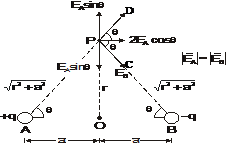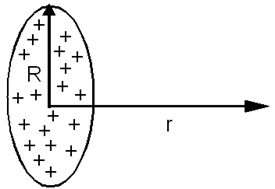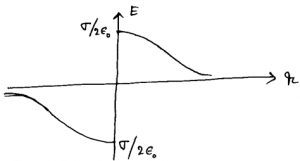Dipole:
Electric Dipole and Dipole Moment: Two equal and opposite charges separated by a distance together constitute a dipole. Dipole moment \(\overrightarrow{P}\) defined as the simple product of magnitude of either charge and the distance of separation between the two charges.
Dipole moment \(\overrightarrow{P}\) defined as the simple product of magnitude of either charge and the distance of separation between the two charges.
\(\overrightarrow{P}\,=\,q\,(2\overrightarrow{a})\).
Dipole moment \(\overrightarrow{P}\) always points from -q to +q. Its SI unit is coulomb metre (Cm).
ELECTRIC FIELD DUE TO A DIPOLE AT A POINT LYING ON AXIAL LINE: Consider an electric dipole consisting of two point charges – q and + q separated by some distance 2a. Let P be an observation point on axial line such that its distance from centre of the dipole is r. If EA is the electric field intensity at P due to charge +q then \({{E}_{A}}\,=\,\frac{1}{4\pi {{\varepsilon }_{0}}}\frac{q}{{{(r+a)}^{2}}}\).
If EA is the electric field intensity at P due to charge +q then \({{E}_{A}}\,=\,\frac{1}{4\pi {{\varepsilon }_{0}}}\frac{q}{{{(r+a)}^{2}}}\).
If EB is electric field intensity at P due to charge – q then \({{E}_{B}}\,=\,\frac{1}{4\pi {{\varepsilon }_{0}}}\frac{q}{{{(r-a)}^{2}}}\).
So, Eaxial = EB – EA (∵ EB > EA)
\({{E}_{axial}}\,=\,\frac{1}{4\pi {{\varepsilon }_{0}}}\frac{q}{{{(r-a)}^{2}}}-\frac{1}{4\pi {{\varepsilon }_{0}}}\frac{q}{{{(r+a)}^{2}}}\).
Since
\({{E}_{axial}}\,=\,\frac{1}{4\pi {{\varepsilon }_{0}}}\frac{4rqa}{{{({{r}^{2}}-\,{{a}^{2}})}^{2}}}\).
p = q (2a)
\({{E}_{axial}}\,=\,\frac{1}{4\pi {{\varepsilon }_{0}}}\frac{2pr}{{{({{r}^{2}}-\,{{a}^{2}})}^{2}}}\).
For r >>>> a
\({{E}_{axial}}\,=\,\frac{1}{4\pi {{\varepsilon }_{0}}}\frac{2p}{{{r}^{3}}}\).
ELECTRIC FIELD DUE TO DIPOLE AT A POINT LYING ON THE EQUATORIAL LINE: Consider an electric dipole consisting of two point charges +q and –q separated by distance 2a. Let P be an observation point on equatorial line such that its distance from mid-point O of the electric dipole is r.
Consider an electric dipole consisting of two point charges +q and –q separated by distance 2a. Let P be an observation point on equatorial line such that its distance from mid-point O of the electric dipole is r.
If EA is the electric field intensity at P due to charge +q
\({{E}_{A}}\,=\,\frac{1}{4\pi {{\varepsilon }_{0}}}\frac{q}{A{{P}^{2}}}=\,\frac{1}{4\pi {{\varepsilon }_{0}}}\frac{q}{({{r}^{2}}\,+\,{{a}^{2}})}\).
EA is represented both in magnitude and direction
If EA is electric field intensity at P due to -q, \({{E}_{B}}\,=\,\frac{1}{4\pi {{\varepsilon }_{0}}}\frac{q}{({{r}^{2}}\,+\,{{a}^{2}})}\) is represented both in magnitude and direction by\(\overline{PC}\) clearly, Let us resolve into two components in two mutually perpendicular directions components of and along the equatorial line cancel each other but the components perpendicular to equatorial line get added up because they act in same direction. So magnitude of resultant intensity at P.
\(E=2{{E}_{A}}\cos \theta \,=2\frac{q}{4\pi {{\varepsilon }_{0}}({{r}^{2}}+{{a}^{2}})}\frac{a}{\sqrt{{{r}^{2}}+{{a}^{2}}}}\).
\({{E}_{equitorial}}=\frac{1}{4\pi {{\varepsilon }_{0}}}\frac{p}{{{({{r}^{2}}+{{a}^{2}})}^{3/2}}}\).
For r >>>>> a
\({{E}_{equitorial}}=\frac{1}{4\pi {{\varepsilon }_{0}}}\frac{p}{{{r}^{3}}}\).
ELECTRIC FIELD INTENSITY AT A GENERAL POINT DUE TO SHORT ELECTRIC DIPOLE:
Let P be the general point. Consider a short electric dipole of dipole moment placed in vacuum. Let O be the midpoint of the dipole. Let the line OP make an angle with Resolving along OP and perpendicular to OP, we get and respectively. Point P is on the axial line of dipole of dipole moment. Let E̅₁ be the electric field intensity at P due to Pcosθ then \({{E}_{1}}=\frac{1}{4\pi {{\varepsilon }_{0}}}\frac{2p\cos \theta }{{{r}^{3}}}\) along PA
Let E̅₁ be the electric field intensity at P due to Pcosθ then \({{E}_{1}}=\frac{1}{4\pi {{\varepsilon }_{0}}}\frac{2p\cos \theta }{{{r}^{3}}}\) along PA
Let be the electric field intensity at P due to E̅
Then \({{\overline{E}}_{2}}=\frac{1}{4\pi {{\varepsilon }_{0}}}\frac{p\sin \theta }{{{r}^{3}}}\) along PB
If E is the magnitude of the resultant electric intensity E̅, then \({{E}^{2}}=E_{1}^{2}+E_{2}^{2}={{\left[ \frac{1}{4\pi {{\varepsilon }_{0}}}\frac{p}{{{r}^{3}}} \right]}^{2}}\left( 4{{\cos }^{2}}\theta +{{\sin }^{2}}\theta \right)\).
or \(E=\frac{1}{4\pi {{\varepsilon }_{0}}}\frac{p}{{{r}^{3}}}\sqrt{3{{\cos }^{2}}\theta +{{\cos }^{2}}\theta +{{\sin }^{2}}\theta }\).
or \(E=\frac{1}{4\pi {{\varepsilon }_{0}}}\frac{p}{{{r}^{3}}}\sqrt{3{{\cos }^{2}}\theta +1}\).
If is the angle which E̅ makes with E̅₁, then \(\tan \beta =\frac{{{t}_{2}}}{{{E}_{1}}}=\frac{1}{4\pi {{\varepsilon }_{0}}}\frac{p\sin \theta }{{{r}^{3}}}\times \frac{4\pi {{\varepsilon }_{0}}{{r}^{3}}}{2p\cos \theta }=\frac{\tan \theta }{2}\).
or \(\beta ={{\tan }^{-1}}\left( \frac{1}{2}\tan \theta \right)\).
Case I: When P lies on the axial line of the dipole or
\(E=\frac{1}{4\pi {{\varepsilon }_{0}}}\frac{p}{{{r}^{3}}}\sqrt{3{{\cos }^{2}}\theta +1}\).
\(E=\frac{1}{4\pi {{\varepsilon }_{0}}}\frac{p}{{{r}^{3}}}\).
\(\tan \beta =\frac{\tan {{0}^{0}}}{2}=0,\,\beta ={{0}^{0}}\).
So, the electric field intensity is along the axial line.
Case II: When P lies on the equatorial line of the dipole
θ = 90° ⇒ cosθ = cos 90° = 0
\(E=\frac{1}{4\pi {{\varepsilon }_{0}}}\frac{p}{{{r}^{3}}}\sqrt{3{{\cos }^{2}}{{90}^{0}}+1}\).
or \(E=\frac{1}{4\pi {{\varepsilon }_{0}}}\frac{p}{{{r}^{3}}}\).
or \(\tan \beta =\frac{\tan {{90}^{0}}}{2}=\infty ,\,\beta ={{90}^{0}}\).
So, the electric field intensity is perpendicular to equatorial line and hence parallel to axial line.
Field intensity at a distance r from a finite line of charge of length L and linear charge density, as shown in the figure. Consider a small element of length dx at a distance x, as shown in figure. The magnitude of the contribution to the field at point P from this element is \(\[dE=\frac{k\lambda dx}{{{r}^{2}}}\).
Consider a small element of length dx at a distance x, as shown in figure. The magnitude of the contribution to the field at point P from this element is \(\[dE=\frac{k\lambda dx}{{{r}^{2}}}\). To carry out the integration, we express the variables in terms of the angle theta,
To carry out the integration, we express the variables in terms of the angle theta,
From the figure
r = R secθ and x = R tanθ on differentiating,
dx = R sec²θ dθ.
Using these expressions (i) may be modified as \(dE=\frac{k\lambda (R{{\sec }^{2}}\theta d\theta )}{{{\left( R\sec \theta \right)}^{2}}}=\frac{k\lambda d\theta }{R}\).
The components of dE are dEx = dE cosθ, dEy = dE sinθ
On integrating \({{E}_{x}}=\frac{k\lambda }{R}\int\limits_{-\beta }^{+\alpha }{\cos \theta d\theta }=\frac{k\lambda }{R}\left[ \sin \alpha +\sin \beta \right]\) and \({{E}_{y}}=\frac{k\lambda }{R}\int\limits_{-\beta }^{+\alpha }{\sin \theta d\theta }=\frac{k\lambda }{R}\left[ \cos \beta -\cos \alpha \right]\).
For any equatorial point,
\(\alpha =\beta ={{\sin }^{-1}}\left( \frac{L}{\sqrt{{{L}^{2}}+4{{r}^{2}}}} \right)\).
∴ \({{E}_{y}}=0\,and\,{{E}_{x}}=\frac{2k\lambda }{R}\left( \frac{L}{\sqrt{{{L}^{2}}+4{{r}^{2}}}} \right)=\frac{2Q}{4\pi {{\varepsilon }_{0}}R}\left( \frac{L}{\sqrt{{{L}^{2}}+4{{r}^{2}}}} \right)\).
Note: For an infinite line of charge, α = π/2 and β = π/2
Therefore,
\({{E}_{x}}=\frac{2k\lambda }{R}\,and\,{{E}_{y}}=0\).
For any axial point,![]() \[E=k\lambda \left( \frac{1}{r}-\frac{r}{r+L} \right)=\frac{Q}{4\pi {{\varepsilon }_{0}}}\left( \frac{1}{r}-\frac{r}{r+L} \right)\]
\[E=k\lambda \left( \frac{1}{r}-\frac{r}{r+L} \right)=\frac{Q}{4\pi {{\varepsilon }_{0}}}\left( \frac{1}{r}-\frac{r}{r+L} \right)\]
Electric field intensity at an axial point at a distance r from the centre of the ring having charge Q which is uniformly distributed over the circumference of a ring. The electric field at P due to the charge element dq of the ring is given by \(\[dE=\frac{1}{4\pi {{\varepsilon }_{0}}}\frac{dq}{{{Z}^{2}}}=\frac{1}{4\pi {{\varepsilon }_{0}}}\frac{dq}{\left( {{R}^{2}}+{{r}^{2}} \right)}\).
The electric field at P due to the charge element dq of the ring is given by \(\[dE=\frac{1}{4\pi {{\varepsilon }_{0}}}\frac{dq}{{{Z}^{2}}}=\frac{1}{4\pi {{\varepsilon }_{0}}}\frac{dq}{\left( {{R}^{2}}+{{r}^{2}} \right)}\).
Hence, the electric field at P due to the uniformly charged ring is given by \(E=\int{dE\cos \theta }=\frac{1}{4\pi {{\varepsilon }_{0}}}\frac{Qr}{{{\left( {{R}^{2}}+{{r}^{2}} \right)}^{3/2}}}\).
\(\left\{ \cos \theta =\frac{r}{Z} \right\}\).
At the centre of the ring, (r = 0), E = 0
The variation of E with r can be seen as The electric field strength is maximum at a point where \(\frac{dE}{dr}=0\Rightarrow r=\pm R/\sqrt{2}\).
The electric field strength is maximum at a point where \(\frac{dE}{dr}=0\Rightarrow r=\pm R/\sqrt{2}\).
∴ \({{F}_{\max }}=\frac{2Q}{3\sqrt{3}\times 4\pi {{\varepsilon }_{0}}{{R}^{2}}}\).
Electric field strength due to a charged disc:- \(E=\frac{2Q}{4\pi {{\varepsilon }_{0}}{{R}^{2}}}\left( 1-\frac{r}{\sqrt{{{R}^{2}}+{{r}^{2}}}} \right)\).
\(E=\frac{2Q}{4\pi {{\varepsilon }_{0}}{{R}^{2}}}\left( 1-\frac{r}{\sqrt{{{R}^{2}}+{{r}^{2}}}} \right)\).
The variation of E with r can be seen as On the surface of the disc
On the surface of the disc
\(E=\frac{2Q}{4\pi {{\varepsilon }_{0}}{{R}^{2}}}=\frac{\sigma }{2{{\varepsilon }_{0}}}\).
